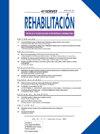乳腺癌化疗患者平衡变化研究
IF 0.4
Q3 Medicine
引用次数: 0
摘要
不稳定是化疗引起的周围神经病变(CIPN)患者在乳腺癌治疗期间的常见症状。姿势照相可能对这些患者的功能评估和管理有用。本研究的目的是通过生物力学评估乳腺癌化疗患者的体位控制变化。材料与方法对39名女性(平均年龄51.0岁,SD 8.9)进行了一项前瞻性纵向观察研究,分别分为I期(n = 14)、II期(n = 18)和III期(n = 7)。评估包括基线、3个月和6个月时的姿势照相、改良的总神经病变评分(mTNS)和EORTC QLQ-CIPN20和EORTC QLQ-C30问卷。结果影像学指标显示前庭功能障碍随时间加重(88.5%,p<;0.01)。体重指数(BMI)与mTNS直接相关(r = 0.361;术中;0.001);BMI还与摇摆面积和前后位位移有关。在3个月和6个月时,发现mTNS和姿势状况之间呈负相关,这与EORTC QLQ-CIPN20 (p<;0.05)。结论乳腺癌患者的体位稳定性受化疗周期的影响。早期识别允许在该患者组中纳入特定干预措施并考虑治疗替代方案。本文章由计算机程序翻译,如有差异,请以英文原文为准。
Estudio de los cambios del equilibrio en pacientes con cáncer de mama tratadas con quimioterapia
Introduction
Instability is a common symptom reported by patients with chemotherapy-induced peripheral neuropathy (CIPN) during breast cancer treatment. Posturography may be useful for the functional assessment and management of these patients. The aim of this study was to evaluate postural control changes through biomechanical assessment in breast cancer patients undergoing chemotherapy.
Material and methods
A prospective longitudinal observational study was conducted with 39 women (mean age 51.0 years, SD 8.9) in stages I (n = 14), II (n = 18), and III (n = 7). Assessments included posturography, the modified Total Neuropathy Score (mTNS), and the EORTC QLQ-CIPN20 and EORTC QLQ-C30 questionnaires at baseline, and at 3 and 6 months.
Results
Posturographic variables showed a pattern of vestibular dysfunction that worsened over time (88.5%, p< 0.01). A direct correlation was observed between body mass index (BMI) and mTNS (r = 0.361; p< 0.001); BMI was also related to sway area and anteroposterior displacement. At 3 and 6 months, inverse correlations were identified between mTNS and posturographic conditions, which were associated with increased symptom severity in all subscales of the EORTC QLQ-CIPN20 (p< 0.05).
Conclusions
Postural stability is affected by chemotherapy cycles in breast cancer patients. Early identification allows for the incorporation of specific interventions in this patient group and the consideration of therapeutic alternatives.
求助全文
通过发布文献求助,成功后即可免费获取论文全文。
去求助
来源期刊

Rehabilitacion
Medicine-Rehabilitation
CiteScore
0.80
自引率
0.00%
发文量
63
期刊介绍:
La revista que es desde hace más de 40 años la publicación oficial de la Sociedad Española de Rehabilitación y referente de la mayoría de las Sociedades de la Especialidad de los países americanos de habla hispana. Se publican 5 números pluritemáticos al año y uno monográfico sobre un tema del mayor interés y actualidad designado por el consejo de redacción.
 求助内容:
求助内容: 应助结果提醒方式:
应助结果提醒方式:


